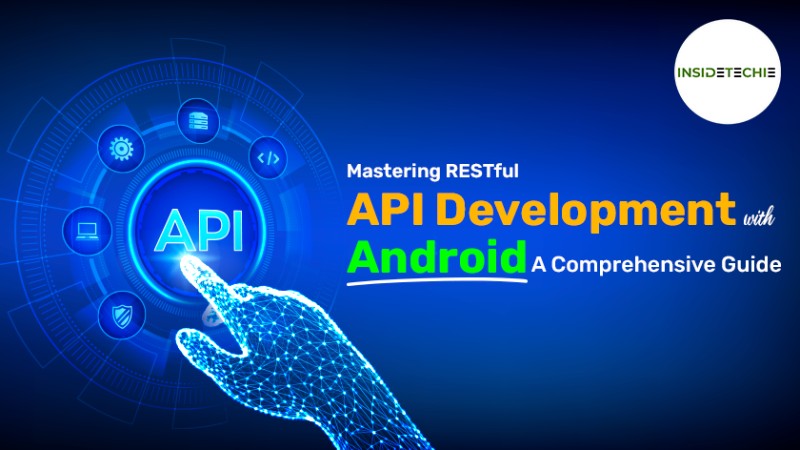In today’s mobile-driven world, the ability to effectively communicate with web servers and integrate data from external sources is essential for building robust and dynamic Android applications. RESTful APIs (Representational State Transfer) provide a standardized way for clients, such as mobile apps, to interact with servers over HTTP, making it a popular choice for mobile app developers. In this comprehensive guide, we’ll explore the ins and outs of RESTful API development with Android, covering everything from understanding REST principles to implementing API calls in your Android app.
Understanding RESTful APIs:
Before diving into development, it’s crucial to understand the fundamental principles of RESTful APIs. We’ll discuss the key concepts, such as resources, HTTP methods (GET, POST, PUT, DELETE), status codes, and URI structure, that form the foundation of RESTful architecture.
Choosing the Right Networking Library:
When considering a networking library for Android development, there are several popular options to explore, each with its own set of features, performance attributes, and community backing. Let’s take a closer look at three prominent choices: Retrofit, OkHttp, and Volley.
Retrofit:
Features: Retrofit stands out for its user-friendly API, making HTTP request handling straightforward. It supports various request methods, URL manipulation, query parameters, headers, and serialization of request/response bodies through converters.
Performance: Leveraging OkHttp as its underlying HTTP client, Retrofit ensures efficient networking performance with support for both asynchronous and synchronous request execution.
Community Support: With its widespread adoption and well-documented resources, Retrofit boasts a large and active community, offering ample support and guidance to developers.
OkHttp:
Features: OkHttp is a robust HTTP client library known for its extensive feature set, including connection pooling, response compression, and request/response interception.
Performance: Recognized for its exceptional performance, OkHttp excels in connection management and automatic response caching, delivering efficient network operations.
Community Support: With its widespread usage and regular updates, OkHttp enjoys strong community backing, providing developers with reliable support and resources.
Volley:
Features: Volley, developed by Google, simplifies network operations in Android apps with features, like request queuing, automatic prioritization, and response caching.
Performance: Volley focuses on speed and efficiency, optimizing HTTP connections and request/response handling for improved performance.
Community Support: While not as active as Retrofit or OkHttp, Volley still maintains a stable and supportive community, making it a viable option for Android developers.
Configuring RESTful APIs on Android:
With a solid understanding of REST principles, let’s delve into the practical aspects of configuring RESTful APIs for Android applications. The Android platform provides robust libraries and frameworks, such as Retrofit and Volley, for making HTTP requests and handling JSON data. We’ll explore how to configure Retrofit, a widely used REST client for Android, to interact seamlessly with RESTful APIs. From defining API endpoints to setting up request headers and handling authentication, we’ll cover the entire configuration process of integrating RESTful APIs in Android applications.
Designing your API:
Designing a well-structured and intuitive API is crucial for ensuring scalability, maintainability, and ease of use. We’ll discuss best practices for API design, including resource naming conventions, versioning strategies, parameter passing, error handling, and documentation using tools like Swagger or OpenAPI.
Implementing API calls in Android:
With a solid understanding of REST principles and API design, it’s time to implement API calls in your Android app. We’ll walk through the process of making GET, POST, PUT, and DELETE requests using various methods, including HttpURLConnection, Retrofit, and Volley. We’ll cover topics like authentication, request headers, request body formatting, and handling responses.
Testing and Debugging:
Testing and debugging are essential steps in the API development lifecycle. We’ll explore techniques for testing API endpoints using tools like Postman or curl, as well as debugging common issues such as network connectivity problems, server errors, and parsing errors in Android.
Securing your API:
Security is a critical aspect of API development, especially when dealing with sensitive data or user authentication. We’ll discuss best practices for securing your API, including HTTPS encryption, authentication mechanisms (e.g., OAuth, JWT), rate limiting, input validation, and protecting against common security threats like SQL injection and cross-site scripting (XSS).
Conclusion:
By immersing yourself in this extensive guide, you’ll acquire the expertise needed to craft RESTful APIs for Android apps with precision. Whether you’re embarking on a fresh API project or weaving existing APIs into your app’s fabric, a firm grasp of REST principles and industry best practices is paramount. Prepare to elevate your Android app development acumen as you delve into the realm of RESTful API development, ensuring your creations are not only top-notch but also scalable and fortified with robust security measures.
 :
https://www.xceltec.com/
:
https://www.xceltec.com/












